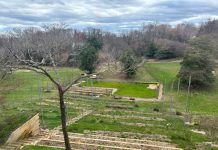By Jenna O’Donnell |
OCEANPORT – The logistics of moving an osprey nest gave rise to a mix of amusement and vexation at a recent borough council workshop.
For some time a breeding pair of osprey were nesting at Blackberry Bay Park on top of an emergency siren in the parking lot. Four years ago, the nest was moved from that roost to a specially built platform closer to the water, but within about 100 yards of a small athletic field at the park.
OCEANPORT – The logistics of moving an osprey nest gave rise to a mix of amusement and vexation at a recent borough council workshop.
For some time a breeding pair of osprey were nesting at Blackberry Bay Park on top of an emergency siren in the parking lot. Four years ago, the nest was moved from that roost to a specially built platform closer to the water, but within about 100 yards of a small athletic field at the park.
Unfortunately, due to the ospreys’ protected status by the state, the proximity of the soccer field to the ospreys’ new nest prevented the recreational use of the field from April to August – the birds’ nesting season. This led Councilman Stuart Briskey to suggest yet another move for the nest.
After weighing the costs involved with the permits and permissions that would be required for such a project, Mayor John “Jay” Coffey said that moving the nest again would not be feasible or worthwhile for the borough.
“We are good with where they are,” Coffey said, noting that the soccer teams had already found another field to use.
The nest was better left alone and hopefully the birds would eventually move on, Coffey said. “Now, can we get away from the ospreys?” he said, referring to the governing body’s agenda.
While the Blackberry Bay Park nest will remain where it is, across town on Riverside Avenue, another osprey nest will soon be moved from a distribution pole to a specially built nesting platform by Jersey Central Power & Light (JCP&L), part of an expanded effort by the utility company to move nests from potentially hazardous utility poles.
“We are good with where they are,” Coffey said, noting that the soccer teams had already found another field to use.
The nest was better left alone and hopefully the birds would eventually move on, Coffey said. “Now, can we get away from the ospreys?” he said, referring to the governing body’s agenda.
While the Blackberry Bay Park nest will remain where it is, across town on Riverside Avenue, another osprey nest will soon be moved from a distribution pole to a specially built nesting platform by Jersey Central Power & Light (JCP&L), part of an expanded effort by the utility company to move nests from potentially hazardous utility poles.
Expanding this program to relocate and discourage ospreys from nesting on electrical equipment is a practical one, said JCP&L spokesman Ron Morano.
“It prevents harm to birds and prevents damage to our equipment that could cause potential outages to our customers,” he said. The company has moved several nests over the years, including two in 2016 and another one in Oceanport in 2013.
“The success of moving nests led us to look in other areas where there was potential, which is why we’ve expanded this program,” Morano said, noting that the company’s work includes identifying likely areas where ospreys might nest and installing equipment to discourage or divert them to safer places.
Ospreys, distinctive raptors with a speckled brown and white plumage, return to the same nests, year after year. They seek high roosts, like utility poles and streetlights, and often nest within sight of the coastal waterways where they dine primarily on fish.
Oceanport’s network of water ways makes it a popular nesting spot for ospreys, who use available materials such as grass, sticks, seaweed and often trash to build large nests that can weigh as much as 200 pounds. The birds’ inclination to build heavy stick nests on dangerous electrical equipment and other utility structures presents unique challenges for coastal towns and conservationists alike. Once an osprey has settled on a particular pole, moving it is not always easy, partly due to the bird’s protected status.
“It prevents harm to birds and prevents damage to our equipment that could cause potential outages to our customers,” he said. The company has moved several nests over the years, including two in 2016 and another one in Oceanport in 2013.
“The success of moving nests led us to look in other areas where there was potential, which is why we’ve expanded this program,” Morano said, noting that the company’s work includes identifying likely areas where ospreys might nest and installing equipment to discourage or divert them to safer places.
Ospreys, distinctive raptors with a speckled brown and white plumage, return to the same nests, year after year. They seek high roosts, like utility poles and streetlights, and often nest within sight of the coastal waterways where they dine primarily on fish.
Oceanport’s network of water ways makes it a popular nesting spot for ospreys, who use available materials such as grass, sticks, seaweed and often trash to build large nests that can weigh as much as 200 pounds. The birds’ inclination to build heavy stick nests on dangerous electrical equipment and other utility structures presents unique challenges for coastal towns and conservationists alike. Once an osprey has settled on a particular pole, moving it is not always easy, partly due to the bird’s protected status.
The New Jersey Division of Fish, Game and Wildlife listed the osprey as endangered in 1973 after pesticide use caused a sharp decline in the state’s osprey population. Since then, the osprey has steadily regained a foothold along the shore, thanks in large part to a passionate group of advocates that has tracked, recorded, repaired and sometimes built platforms for nests.
The increased efforts by JCP&L to move nests to safety has been praised by conservation groups including the Conserve Wildlife Foundation of New Jersey, a nonprofit that works with the state on osprey management and conservation. In a release in December, Ben Wurst, habitat program manager at Conserve Wildlife Foundation, praised JCP&L’s proactive protections for a growing osprey population in the state.
“To an osprey, a utility pole near the coast seems like an ideal spot to perch or build a nest, but it could jeopardize their health,” he said in the statement. JCP&L’s program “will help ospreys coexist with the demands of our modern society.”
The increased efforts by JCP&L to move nests to safety has been praised by conservation groups including the Conserve Wildlife Foundation of New Jersey, a nonprofit that works with the state on osprey management and conservation. In a release in December, Ben Wurst, habitat program manager at Conserve Wildlife Foundation, praised JCP&L’s proactive protections for a growing osprey population in the state.
“To an osprey, a utility pole near the coast seems like an ideal spot to perch or build a nest, but it could jeopardize their health,” he said in the statement. JCP&L’s program “will help ospreys coexist with the demands of our modern society.”














